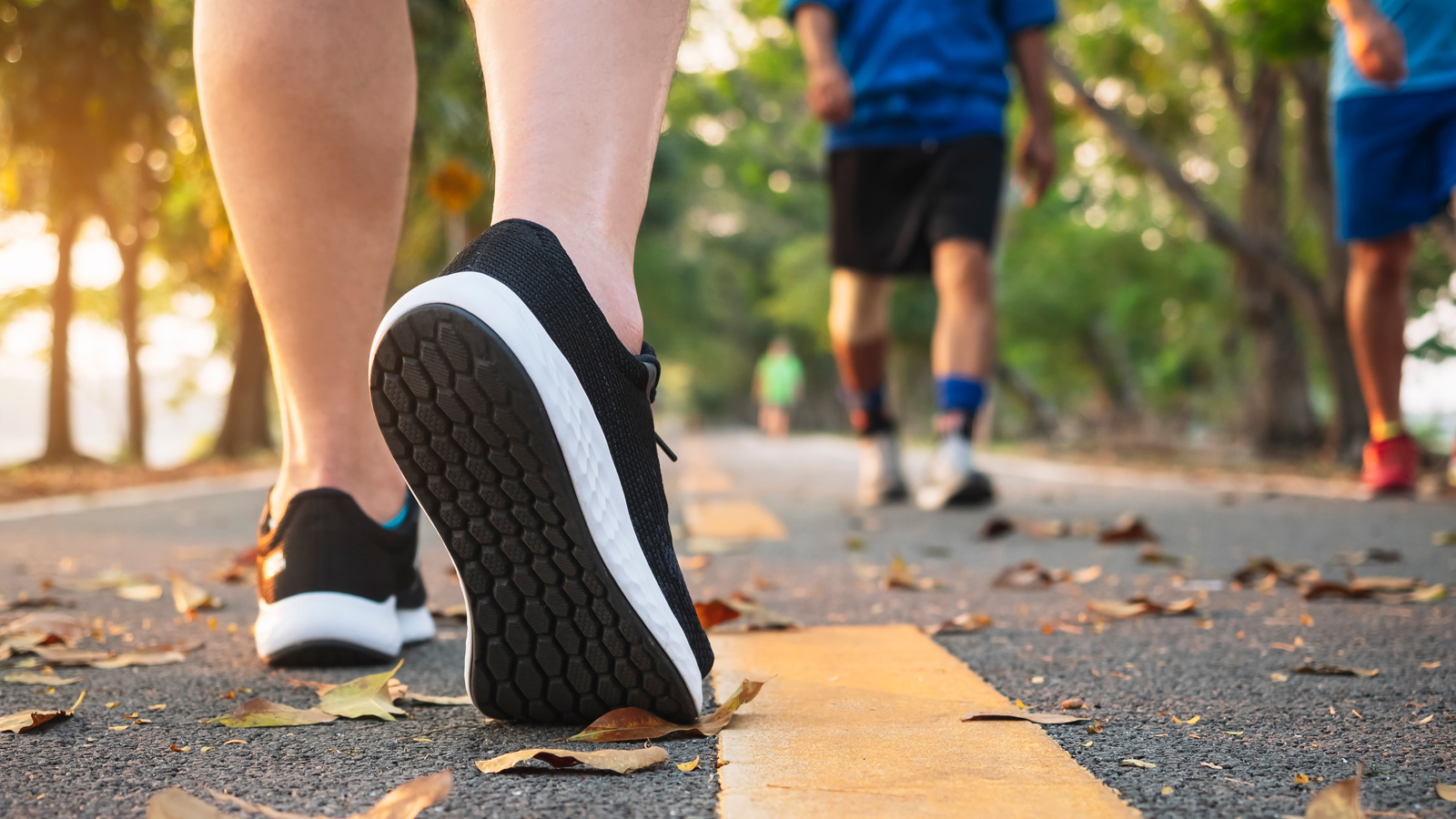Walking Workouts: Add Intensity For Better Weight Loss
Walking is well known as a simple, low-impact exercise that comes with many health benefits from improving cardiovascular health to boosting mental well-being.
But is walking enough to help with weight loss? The answer is yes and no. If you’re new to walking and your fitness level is low, just walking for 30 minutes a day can help you to lose weight. But if you’ve hit a weight loss plateau and you’re looking to improve your fitness level – it’s time to add intensity to your walking workouts!

Are Walking Workouts Effective?
Simply walking is enough to get active, lose weight and improve your health and fitness. Walking can help to burn body fat and improve muscle mass in your core and lower body.
But adding intensity to your walks with incline walking, walking intervals, and using walking poles or even weights, can help you get the most out of your sessions.
How To Choose A Walking Workout?
Pick a walking workout based on your fitness level, how much time you want to commit, and the level of intensity.
Always start with an easy session and build up from there. If you’re a beginner walker aim for a 20 to 30-minutes walk at a comfortable pace.
As your fitness improves, try increasing your pace or walking further and experimenting with adding intensity.
Does Walking Workout Your Whole Body?
Walking is a great way to work out your legs and core muscles. As you walk, your glutes, quads, and hamstrings are working to propel you forward and help support your weight.
Your abs and obliques also play an important role by keeping your body upright and stable during a walk.
Walking doesn’t typically workout your upper body but you can give your arms a workout by using walking poles or hand weights.
Adding Intensity To Your Workout
As you get fitter, most people will benefit from adding one or two high-intensity walking sessions to their weekly workouts.
Follow up a high-intensity workout with a recovery walk the following day and make sure your weekly schedule has a mix of shorter brisk walks and longer easier walks.
Here are some of the best ways to add intensity to your walking workouts:
Walking Intervals
Alternate between short bursts of speed walking and slower-paced recovery walking. As you get fitter, make the speed walking bursts a little longer and the recovery periods shorter.
Incline Walking
Adding hills to your walks is a great way to increase intensity and calorie burn.
Choose a hilly route and make some effort on the hills or try hill intervals where you power up a suitable incline over a set distance and recover on the descent. Rinse and repeat!
Walking Poles
Termed Nordic Walking, walking with poles copies the action of cross-country skiers. Using poles makes you use both your arms and your legs to power yourself forward.
It’s a great way to get fitter faster – used properly, walking poles significantly increase oxygen use and calorie burn for the same perceived exertion.
Using Weights
Carrying a backpack, using a weighted vest, wrist weights, or holding dumbbells – these are all ways of walking with weights and making your walks harder.
The added weight will increase your calorie burn on the flat and especially if you start walking uphills.
A tip is to increase the weight you’re carrying gradually and be wary of carrying too much weight if you’re walking down steep descents.
Varied Terrain
Mix up the terrain of your walks – walk on the beach, power up a sand dune, or walk on a grassy or rocky trail. You’ll feel those leg muscles burn!
The added resistance from walking on different surfaces will make you work harder, improve your balance and make you stronger.

30-Minute Walking Workout Sessions
Here are a few 30-minute walking workout sessions to help you increase intensity and maximize your weight loss efforts:
#1 Interval Walking Workout:
- Warm-up: 5-minute moderate pace.
- Repeat the following set 6-8 times:
- 2 minutes of fast walking or speed walking,
- 1 minute of moderate-paced walking for recovery.
- Cool-down: 5-minutes easy pace.
#2 Hill or Incline Walking Workout 1:
- Warm-up: 5-minute moderate pace on a flat surface.
- 20 minutes of hill or incline walking (try to maintain a steady pace and challenge yourself on steeper inclines).
- 5-minute easy pace on a flat surface to recover.
#3 Hill or Incline Walking Workout 2:
- Warm-up: 5-minute moderate pace on a flat surface.
- Repeat the following set 4-6 times:
- 2-minute brisk walking pace walking uphill,
- 2-minute easy descending.
- 5-minute easy pace on a flat surface to recover.
#4 Weighted Walking Workout:
- Warm-up: 5-minute moderate pace without added weight.
- 20 minutes of walking while wearing a weighted vest (start with lighter weights and gradually increase weight as you build strength and endurance).
- Cool-down: 5-minute easy pace without added weight.
#5 Power Walking Workout:
- Warm-up: 5-minute moderate pace.
- 20 minutes of power walking (maintain a fast, consistent pace, and incorporate arm movements or walking poles to engage your upper body).
- Cool-down: 5-minute easy pace.
#6 Mixed Terrain Walking Workout:
- Warm-up: 5-minute moderate pace on a flat level surface.
- 20 minutes of walking on mixed terrain (alternate between flat surfaces, inclines, and uneven surfaces such as sand dunes, beaches, and rocky or grassy trails, to challenge your muscles and balance). Keep working hard and vary your pace. Push hard up inclines and ease off on descents.
- Cool-down: 5-minute gentle walk on a flat surface.
#7 Trim Trail:
Trim trails were popular in the 80s and were a great way to add strength training to your cardio workouts. Unless you’re lucky enough to have one nearby, you can replicate the benefits of a trim trail with a walking-for-fitness version!
- Warm-up: 5-minute moderate pace.
- Repeat the following set 5 times:
- Brisk walking 4 minutes
- Strength training for 1 minute: Walking lunges, step-ups, monster walks, reverse lunges, or split squats.
- Cool-down: 5-minute easy walk on a flat surface.
Remember to start with shorter sessions and gradually increase the duration and intensity as your fitness level improves. Mixing and matching these workouts throughout the week can keep your routine fresh and exciting, making it easier to stay committed to your walking workout plan.

Thoughts From Love Life Be Fit
The health benefits of walking extend far beyond weight loss, losing belly fat, and weight maintenance. It’s one of the best ways to improve your cardiovascular fitness, lower blood pressure, boost your immune system, increase energy levels, and even help with your mental health.
Regular physical activity is key. Aim for at least a 30-minute daily walk. You can increase your daily steps by splitting up your walks into 2 or 3 sessions.
Increasing the intensity level is a good way to get the most from your walking program – just make sure you warm up first! Mixing up your walking routine with a power walk, walking intervals, or adding hills is an excellent way to get the most out of your sessions.
Running 101 Training Guides & Walking Schedules
5K Training Plans
- Couch To 5K Beginner Training Plan
- 12 Week 5K Training Plan
- 10 Week 5K Training Plan
- 8 Week 5K Training Plan
- 6 Week 5K Training Plan
- 4 Week 5K Training Plan
- 5K Training Plan Intermediate





